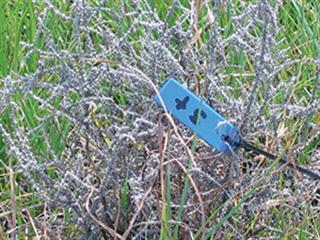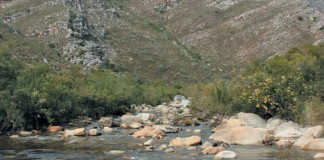
Slangbos (Seriphium plumosum), an unpalatable invader, is increasingly destroying grazing in parts of the Eastern Cape, Free State, North West, Mpumalanga, and Gauteng. Fortunately, the scourge can be treated effectively through chemical control, albeit at considerable cost. But this is money well spent, says Prof Hennie Snyman of the Department of Animal and Wildlife and Grassland Sciences, University of the Free State.
“The bush can lower grazing capacity of productive grassveld by up to 80%, yet stock farmers are often wary of spending money on control because they’re not convinced the cost is worth it,” he says. “However, several farmers have improved the grazing capacities of their farms by eradicating slangbos. They believe the money is well spent simply because it increases the number of animals they can keep.”
Unfortunately, many farmers fail to realise that slangbos is lowering their grazing capacity, because the process occurs slowly, and this can lead to overstocking. “If you have serious slangbos infestation, you must reduce stock to prevent overgrazing,” warns Prof Snyman. He suggests that farmers measure the cost of chemical control against the loss of a farm’s value if slangbos is not controlled.
“It’s puzzling that a farmer whose grazing capacity has dropped by, say, 70% on veld that is worth R6 000/ha should
not be prepared to spend R300/ha on chemicals,” he says. Where slangbos has lowered grazing capacity by 50% (2 000 to 3 000 slangbos plants/ha), the cost of applying a herbicide at R350/ha can be recouped in under three years when farming with woolled sheep and a little longer when farming with cattle.
Correct treatment
To avoid damage to grass, chemicals must be applied correctly and at the right strength. What is most important, though, is follow-up treatment. Small stands of slangbos should be treated by hand spraying or by placing pellets around the stems. While some farmers concoct their own mixtures, it is far better to obtain advice from chemical companies and use a cost-effective, environmentally sound solution. “To avoid damaging grasses, the products must be applied correctly and at the recommended strength,” he stresses.
Check list
Remove any single slangbos plants by pulling or chopping them out and burning them elsewhere. Do this before they set seed – this occurs between February and April. Where dense stands occur, apply chemicals by air, tractor or hand. Seek advice on the right chemical to use. (Molopo is often recommended.) Tackle the camps where infestation is lightest first, then the more seriously affected camps.
Other methods of control
- Mechanical (Chopping). This has several disadvantages – it is labour-intensive, stimulates germination, and disperses seeds. However, the weed can be controlled successfully in this way if density is low and if it is done before seed set. Remember, however, that seeds can remain in the bush for up to nine months before being spread by wind or animals.
- Fire. This works effectively only with young plants; the vast majority of mature bushes survive. In fact, fire stimulates germination.
- Biological. Due to high rainfall this year, a fungus, Endophyllum elytroppi, has been noted on slangbos. This kills affected parts of the bush, turning the leaves yellow or light green and the stems orange, brown or red. However, developing biological slangbos control measures from the fungus is complicated by the fact that it is difficult to produce enough spores for commercial purposes on the host plant.
- Utilisation. Spraying molasses or other appetite stimulants onto the slangbos to make it palatable could also be a future solution to the problem, as the young plants are relatively high in protein. However, because the invader becomes completely unpalatable once it has reached a certain height, total utilisation is impossible, even under high-pressure grazing. Slangbos should never, in any case, be allowed to replace the grass component in the veld. Sheep and cattle do tend to graze the seed tops as well as young plants at certain times of the year, and the eland has even developed a preference for slangbos. “But this might even help seed distribution as we do not know much about the survival of seed that has gone through the alimentary canal,” says Prof Snyman.
Contact Prof Hennie Snyman on 051 401 2221.













